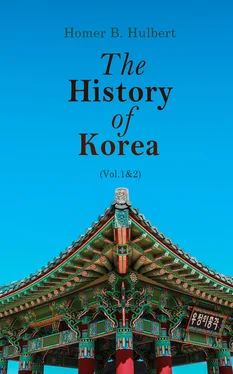It must not be imagined that these three kingdoms of Sil-la, Ko-gu-ryŭ and Păk-je, which represented so strongly the centripetal idea in government, were allowed to proceed without vigorous protests from the less civilized tribes about them. The Mal-gal tribes in the north, the Suk-sin and North Ok-jŭ tribe in the north-east and Ye-măk in the east made fierce attacks upon them as opportunity presented. The Mal-gal tribes in particular seem to have penetrated southward even to the borders of Păk-je, probably after skirting the eastern borders of Ko-gu-ryŭ. Nominally Ko-gu-ryŭ held sway even to the Japan Sea but practically the wild tribes roamed as yet at will all through the eastern part of the peninsula. In the eighth year of On-jo’s reign, 10 B.C., the Mal-gal forces besieged his capital and it was only after a most desperate fight that they were driven back. On-jo found it necessary to build the fortresses of Ma-su-sŭng and Ch’il-chung-sŭng to guard against such inroads. At the same time the Sŭn-bi were threatening Ko-gu-ryŭ on the north, but Gen. Pu Bun-no lured them into an ambush and routed them completely. The king rewarded him with land, horses and thirty pounds of gold, but the last he refused.
The next year the wild men pulled down the fortresses lately erected by King On-jo and the latter decided that he must find a better site for his capital. So he moved it to the present site of Nam-han, about twenty miles from the present Seoul. At the same time he sent and informed the king of Ma-han that he had found it necessary to move. The following year he enclosed the town in a wall and set to work teaching agriculture to the people throughout the valley of the Han River which flowed near by.
In the year which saw the birth of Christ the situation of affairs in Korea was as follows. In the north, Ko-gu-ryŭ, a vigorous, warlike kingdom, was making herself thoroughly feared by her neighbors; in the central western portion was the little kingdom of Păk-je, as yet without any claims to independence but waiting patiently for the power of Ma-han so to decline as to make it possible to play the serpent in the bosom as Wi-man had done to Ki-ja’s kingdom. In the south was Sil-la, known as a peaceful power, not needing the sword because her rule was so mild and just that people from far and near flocked to her borders and craved to become her citizens. It is one of the compensations of history that Sil-la, the least martial of them all, in an age when force seemed the only arbiter, should have finally overcome them all and imposed upon them her laws and her language.
Table of Contents
Change of Ko-gu-ryu capital. … Sil-la raided. … Legend of Suk-ta’l-ba … fall of Ma-han … beginning of Chinese enmity against Ko-gu-ryu … the three kingdoms differentiated. … King Yu-ri degraded … extension of Ko-gu-ryu. … Japanese corsairs … remnant of Ma-han revolts … fall of Pu-yu … origin of in-gum … siege of Ko-gu-ryu capital raised. … Sil-la’s peaceful policy … patronymics … official grades … unoccupied territory … kingdom of Ka-rak … legends … position … dependencies.
We read that in 2 A.D. the king of Ko-gu-ryŭ was about to sacrifice a pig to his gods, when the pig escaped and taking to its heels was chased by the courtier Sŭl-chi into the district of Kung-nă. He caught the animal near Wi-na Cliff, north of the Ch’o-san of today. When he returned he described the place to the king as being rough and consequently suitable for the site of a capital. Deer, fish and turtles also abounded. He gave such a glowing account that the king was fain to move his capital to that place, where it remained for two hundredhundred and six years.
In 4 A.D. Hyuk-kŭ-se, the wise king of Sil-la died and seven days later his queen followed him. It is said that they were so completely one that neither could live without the other. Nam-hă his son, with the title of Ch’a-ch’a-ung, reigned in his stead. A remnant of the Nang-nang tribe, hearing of the death of King Hyŭk-kŭ-se, thought it a fitting time to make a raid into Sil-la territory, but they were beaten back.
In the third yearyear of his reign, Nam-hă built a shrine to his father and then put the management of the government into the hands of a man named Sŭk-t’al-hă who had become his son-in-law. This man is one of the noted men of Sil-la and his origin and rise are among the cherished traditions of the people.
Somewhere in north-eastern Japan there was a kingdom known as Ta-p’a-ra and there a woman, pregnant for seven years, brought forth an egg. The neighbors thought it a bad omen and were minded to destroy it but the mother, aware of their intentions, wrapped the egg in silk and cotton and placing it in a strong chest committed it to the waters of the Japan Sea. In time it drifted to A-jin Harbor on the coast of Sil-la where an old fisherwoman drew it ashore and found upon opening it that it contained a beautiful child. She adopted him and reared him in her humble home. It was noticed that wherever the child went the magpies followed him in flocks, so they gave him the name of Sŭk, the first part of the Chinese word for magpie. The second part of his name was T’al, “to put off” referring to his having broken forth from the egg, and the final syllable of his name was Hă meaning “to open” for the fishwife opened the chest. This boy developed into a giant both physically and mentally. His foster-mother saw in him the making of a great man, and so gave him what educational advantages she could afford. When he had exhausted these she sent him to enter the service of the great statesman Pyo-gong the same that had acted as envoy to Păk-je. Pyo-gong recognised his merit and introduced him at court where his rise was so rapid that ere long he married the king’s daughter and became vicegerent of the realm, the king resigning into his hands the greater part of the business of state.
The year 9 A.D. beheld the fall of the kingdom of Ma-han. We remember that Ki-jun became king of Ma-han in 193 B.C. He died the same year and was succeeded by his son Ki-t’ak with the title Kang-wang, who ruled four years. It was in 58 B.C. that Ki-jun’s descendant Ki-hun (Wun-wang) ascended the throne. It was in the second year of his reign that Sil-la was founded and in his twenty-second year that Ko-gu-ryŭ was founded. After twenty-six years of rule he died and left his son, Ki-jŭng, to hold the scepter. It was this king who, in his sixteenth year gave On-jo the plot of land which became the seat of the kingdom of Păk-je. Twenty-six years had now passed since that act of generosity. Păk-je had steadily been growing stronger and Ma-han had as steadily dwindled, holding now only the two important towns of Wŭn-san and Köm-hyŭn. In fact some authorities say that Ma-han actually came to an end in 16 B.C. at the age of 177 years but that a remnant still held the towns of Wŭn-san and Köm-hyŭn. The balance of proof is however with the statement that Ma-han kept up at least a semblance of a state until 9 A.D.
The first sign of hostile intent on the part of Păk-je against her host, Ma-han, had appeared some years before, when Păk-je had thrown up a line of breast-works between herself and the capital of Ma-han. The latter had no intention of taking the offensive but Păk-je apparently feared that Ma-han would divine her hostile intent. Ma-han hastened to send a message saying “Did I not give you a hundred li of land? Why do you then suspect me of hostile designs?” In answer, Păk-je partly from shame and partly because she saw that Ma-han was wholly unsuspicious of her ulterior designs, tore down the barriers and things went on as before. But now that Ma-han was utterly weak, the king of Păk-je decided to settle the matter by one bold stroke. He organised a great hunting expedition and under cover of this approached the Ma-han capital and took it almost without resistance. Thus, as Wi-man had paid back the kindness of Ki-jun by treachery so now again On-jo paid back this last descendant of Ki-jun in the same way.
Читать дальше












